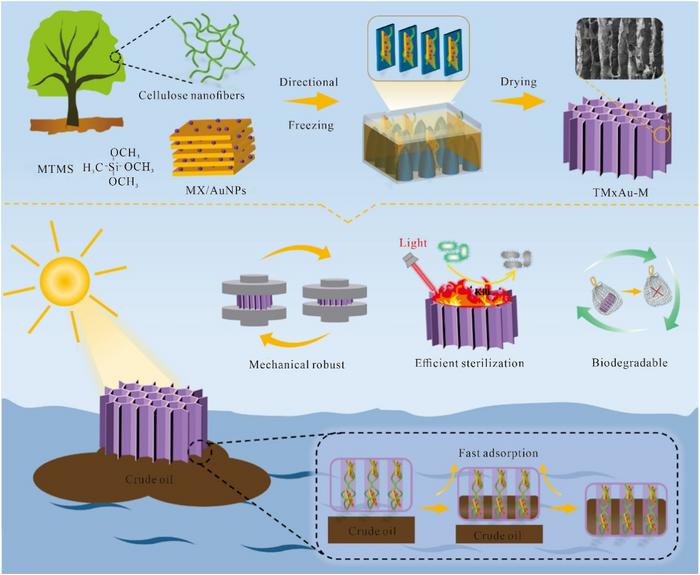Researchers from the South China University of Technology have made significant strides in environmental science with the development of a new robust MXene aerogel incorporated with cellulose nanofibers and gold nanoparticles, specifically engineered to tackle the increasing global prevalence of oil spills. As the frequency of oil spills and industrial discharges continues to rise, traditional strategies for remediation struggle against the high viscosity of crude oil, demanding innovative solutions. This cutting-edge aerogel, designed for efficient crude oil spill cleanup, harnesses advanced materials science and novel fabrication techniques to offer a promising approach to address these pressing environmental issues.
The newly formulated MXene aerogel features unique structural properties that enhance its performance in oil absorption while also providing exceptional mechanical strength. The unique combination of MXene, a two-dimensional material known for its outstanding properties, with cellulose nanofibers provides the aerogel with significant compressive strength and durability. This multifunctional material not only exhibits impressive hydrophobicity, crucial for oil absorption, but also maintains its structural integrity even under extreme conditions.
To create this innovative aerogel, researchers utilized directional freeze-drying technology—a method that allows for precise control over the aerogel’s structure and porosity. This technique results in an intricate network of pores within the aerogel, optimizing its ability to interact with and absorb various oils. The incorporation of gold nanoparticles further enhances the aerogel’s photothermal properties, enabling it to absorb light and convert it into heat. This critical feature significantly increases the aerogel’s efficiency in extracting viscous crude oil from environmental disasters, effectively addressing a long-standing shortcoming in existing remediation materials.
In rigorous testing, the aerogel displayed remarkable mechanical properties, retaining up to 85.7% of its strain capacity after undergoing 30 cycles of compression and release at a staggering 90% strain. This performance not only indicates the aerogel’s structural resilience but also its potential for repeated use, making it an economically and environmentally sustainable option for oil spill remediation. The impressive water contact angle of 145 degrees underlines the material’s hydrophobic nature, confirming its idea as an excellent candidate for applications in water-based environments where oil spills are rife.
Perhaps one of the most exciting aspects of this innovative aerogel is its ability to rapidly heat up under near-infrared light to temperatures as high as 76°C. This capability plays a pivotal role in further enhancing its efficiency in absorbing viscous crude oils. As the temperature rises, the aerogel can effectively lower the viscosity of the crude oil, thereby promoting faster and more efficient absorption rates. Such developments are vital in ensuring that oil spills are dealt with promptly, minimizing the ecological impact and increasing the likelihood of successful remediation.
Moreover, this unique aerogel demonstrates an impressive versatility, not only being effective in oil spill scenarios but also exhibiting long-lasting antimicrobial properties. Such characteristics broaden its potential applications, paving the way for its use in various environmental and industrial contexts. The incorporation of biodegradable materials ensures that, once its purpose is fulfilled, the aerogel can decompose, thereby mitigating any adverse environmental consequences, a crucial consideration in the realm of waste management and sustainability.
The research aligns with global efforts aimed at developing sustainable practices that address environmental concerns effectively. The pressing nature of environmental degradation due to oil contamination highlights the necessity for innovation in the materials used for remediation. The implications of employing this novel MXene aerogel extend beyond mere oil spill absorption; they represent a leap toward responsible environmental stewardship.
Moving forward, the findings surrounding this robust aerogel bode well for future developments in materials science aimed at addressing environmental challenges. Further investigations are warranted to explore the full potential and applications of the aerogel in diverse settings, including its applicability in other fluid absorption scenarios. The work underscores the importance of interdisciplinary approaches in scientific research, combining principles from materials science, environmental engineering, and industrial applications to pave the way for holistic solutions to age-old problems.
As awareness around environmental issues and oil spills heightens, this advanced aerogel could not only transform the landscape of remediation techniques but also influence policy decisions regarding environmental protection and the adoption of sustainable technologies globally. The successful outcome of this research signifies a meaningful contribution that could potentially change how we respond to oil-related disasters in the future.
In conclusion, the creation of this MXene aerogel constitutes a monumental step forward in material advancements aimed at combatting oil spills effectively. Its compelling properties, innovative design, and mechanistic understanding provide a comprehensive solution to an urgent issue threatening ecosystems worldwide. With further exploration and application, this aerogel could mark a new era in environmental remediation, paving the way for cleaner, safer ecosystems.
—
Subject of Research: Efficient Crude Oil Spill Remediation
Article Title: Robust MXene Aerogel Assisted by Cellulose Nanofiber for Efficient Crude Oil Spill Remediation
News Publication Date: Not applicable
Web References: Not applicable
References: Not applicable
Image Credits: State Key Laboratory of Pulp and Paper Engineering, South China University of Technology, Guangzhou, China
Keywords: Aerogel, Environmental remediation, Petroleum, Nanofibers, Hydrophobicity, Economic development, Sustainable development, Porous materials




